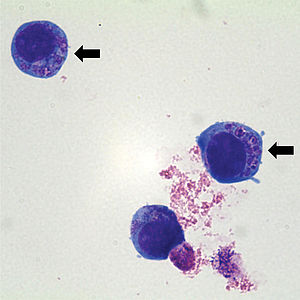Human granulocytic anaplasmosis
| Human granulocytic anaplasmosis | |
|---|---|
| Synonyms | Human granulocytic ehrlichiosis (HGE) |
 |
|
| Anaplasma phagocytophilum cultured in human | |
| Classification and external resources | |
| Specialty | infectious disease |
| ICD-10 | A79.8 |
| ICD-9-CM | 083.8 |
| DiseasesDB | 31663 |
| MedlinePlus | 001381 |
| eMedicine | med/3391 ped/655 emerg/159 |
| MeSH | D016873 |
Human granulocytic anaplasmosis (HGA) is a tick-borne, infectious disease caused by Anaplasma phagocytophilum, an obligate intracellular bacterium that is typically transmitted to humans by ticks of the Ixodes ricinus species complex, including Ixodes scapularis and Ixodes pacificus in North America. These ticks also transmit Lyme disease and other tick borne diseases.
The bacteria infect white blood cells called neutrophils, causing changes in gene expression that prolong the life of these otherwise short-lived cells.
Signs and symptoms may include:
Symptoms may be minor, as evidenced by surveillance studies in high-risk areas. Gastrointestinal tract symptoms occur in less than half of patients and a skin rash is seen in less than 10% of patients. It is also characterized by a low number of platelets, a low number of white blood cells, and elevated serum transaminase levels in the majority of infected patients. Even though people of any age can get HGA, it is usually more severe in the aging or immune-compromised. Some severe complications may include respiratory failure, kidney failure, and secondary infections.
A. phagocytophilum is transmitted to humans by Ixodes ticks. These ticks are found in the US, Europe, and Asia. In the US, I. scapularis is the tick vector in the East and Midwest states, and I. pacificus in the Pacific Northwest. In Europe, the I. ricinus is the main tick vector, and I. persulcatus is the currently known tick vector in Asia.
...
Wikipedia
